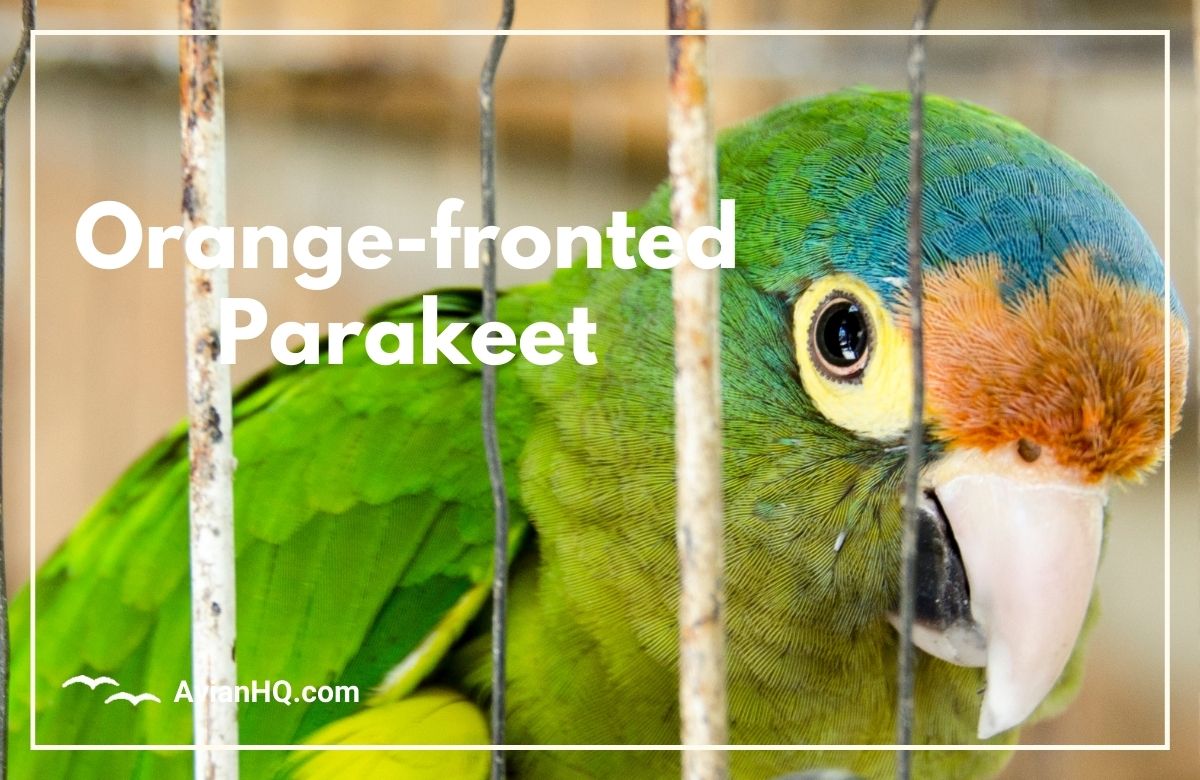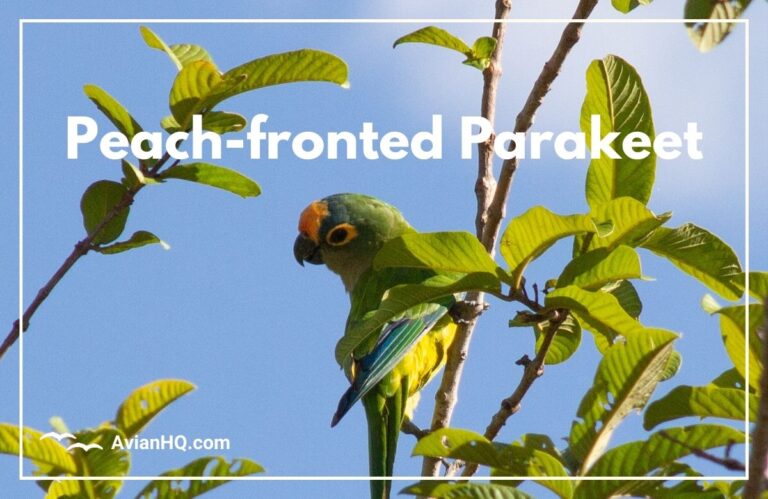Orange-fronted Parakeet (Eupsittula canicularis)
Bright green feathers with splashes of blue, an orange patch on its forehead – you’d certainly notice an Orange-fronted Parakeet if it landed nearby! These colorful birds stand out with their unique looks. About the size of a fist, they’re bigger than a budgie but still one of the smaller parakeet species.
You’ll find these little parrots living in Mexico and Central America in tropical forests and savannas. They travel in noisy flocks, squawking to keep in contact as they fly between trees looking for fruit and seeds to eat.
Orange-fronted Parakeets roost in tree cavities at night and nest there too during the breeding season. Each mated pair raises one clutch of eggs per year. They are loyal birds, pairing up with the same mate every year.
Though small, Orange-fronted Parakeets have big personalities! Their constant chatter and antics make them fun to watch in the wild or as pets. Despite having a wide natural range, habitat loss has reduced their numbers in some areas. Still, their stable overall population earns them a conservation status of Least Concern.
So read on to learn all about the natural history of this eye-catching parakeet! We’ll cover their classification, physical appearance, habitat, eating habits, breeding behaviors, ecology, current conservation efforts and cultural significance across their native lands.
History and Taxonomy
The Orange-fronted Parakeet’s scientific name is Eupsittula canicularis. It is named for its distinctive orange forehead patch.
This species was first scientifically described in 1843 by the French naturalist Charles Lucien Bonaparte. He gave it the scientific name Psittacara canicularis, classifying it in the large parrot genus Psittacara.
In recent years, taxonomists have reclassified the Orange-fronted Parakeet into its current designated genus Eupsittula. This genus contains several other small Central American parakeet species.
Based on DNA evidence and behavioral observations, the Orange-fronted Parakeet’s closest relatives are believed to be the Olive-throated Parakeet, Aztec Parakeet, and Brown-hooded Parakeet. All species in this group are placed in the tribe Arini, one of the main parakeet tribes.
There are no recognized subspecies of the Orange-fronted Parakeet. Their green and blue plumage shows some natural geographic variation across populations, but not enough to divide them into separate subtypes.
Physical Appearance
The Orange-fronted Parakeet is a small-sized parrot, measuring around 9 inches (22 to 23 centimeters) long from the tip of its tail to the end of its beak. It weighs approximately 1.5 to 2 ounces (40 to 60 grams).
Its most distinctive feature is the bright orange patch on its forehead, which gives this bird its common name. The forehead coloring is more extensive in the adult males.
The plumage is mostly green on the back and wings, with more blue-tinged flight feathers. The throat area is also blue, while the belly is greenish-yellow. The tail feathers display blue tips. The beak is pale grey.
Males and females look similar, but the adult females have less orange on the head and neck. Juvenile birds lack the vivid forehead coloring, having more green feathers on the crown instead. Their plumage colors become brighter and more defined as they mature over their first year.
Regional variations exist in the wild, with some northern populations containing more yellow in their belly feathers while southern birds may show more blue on the wings. But differences across subspecies have not been formally described.
Habitat and Distribution
The Orange-fronted Parakeet is native to Mexico and Central America. Its range extends from southern Mexico through Guatemala, El Salvador, Honduras, Nicaragua, and northern Costa Rica.
This parakeet inhabits tropical evergreen forests, deciduous woodlands, and savannas. It tends to avoid densely forested areas. The elevation of its habitats ranges from sea level up to about 5,000 feet (1,500 meters).
Some of the strongest remaining populations are found in El Salvador and Nicaragua. But habitat loss has caused localized declines, especially in Costa Rica and western Mexico where deforestation has been more extensive.
Orange-fronted Parakeets need trees for roosting, nesting and foraging. They do adapt to live in open woodlands, pastures and agricultural areas if sufficient large trees remain. Access to standing dead trees and palms for nesting sites is particularly important.
They may wander locally between breeding and non-breeding seasons seeking out food sources. But most populations do not migrate over long distances. The parakeets generally only make seasonal elevational movements to follow ripening fruit crops.
Diet and Feeding
The Orange-fronted Parakeet is mainly herbivorous, feeding on a variety of fruits, seeds, flowers and flower buds from trees and scrubs.
Favored fruit and nut crops include mangos, Cashew apples, Guanacaste tree pods and Ceiba tree seed pods. They supplement this plant diet with some insect protein, occasionally eating caterpillars, beetles and ants.
These parakeets use their curved beaks adeptly to extract seeds and nuts. Strong legs and feet allow them to cling to branches while they nibble and bite plant materials.
They feed actively in the morning and late afternoon, gathering in small flocks. During midday they rest and preen themselves to keep their colorful feathers in good condition.
Orange-fronted Parakeets need to drink water frequently when eating drier foods. So they are often spotted gathering near rivers and streams or water ponds and containers put out by homeowners.
As with other parrot species, these parakeets regurgitate and rechew bits of their food during digestion. This helps them more efficiently access nutrients from the plant cell walls.
Breeding and Reproduction
Orange-fronted Parakeets reach sexual maturity and begin breeding efforts at around 2 to 3 years of age. The breeding season is aligned with the wet season, which varies across their range but generally runs from April through August.
These parakeets form monogamous breeding pairs that cooperate in raising young. Pairs often stay together across multiple seasons and may use the same nest site for up to five years.
To attract and court mates, the male parakeets make display flights and feed seed pods to females. Once paired, the couple collaborates to prepare a nest inside a tree cavity, chewing wood and carrying materials in to line the bottom.
Females typically lay three to four eggs per clutch. The eggs are white and about 0.9 inches (24 mm) long. Only the female incubates the eggs, for a period around 26 days.
Both parents help feed the hatchlings a diet of regurgitated softened seeds and fruit. Young parakeets start leaving the nest at eight weeks old, but continue to be fed and taught by their parents for a few more weeks as they learn to forage on their own. Parents are very protective of the nest site during this time.
On average, Orange-fronted Parakeets in the wild have a lifespan of approximately 20 years. So a mated pair may successfully raise multiple broods together over time once they bond.
Behavior and Ecology
Orange-fronted Parakeets are highly social, spending most of their time traveling and interacting in small flocks. These flocks often contain just family groups during breeding seasons. But in the non-breeding periods, they may gather with other parakeets in larger, noisy community flocks numbering in the dozens.
They communicate constantly with a variety of loud squawks and chatters as they fly. This vocal activity forges social bonds and allows them to coordinate foraging, predator alerts and other activities. Their flocking behavior provides safety in numbers from potential predators like hawks and snakes.
This parakeet is most active in the mornings and late afternoons. At midday they become quieter, seeking shelter to rest out of the hottest sunlight.
At night the whole flock will roost communally inside a tree hollow or palm grove. They prefer to sleep in the same tree cavity night after night, lining the floors with fresh green leaves for comfort.
Orange-fronted Parakeets exhibit some territorial behavior around favored nest sites and fruit trees. But generally they integrate smoothly when mingling with other parrot species in shared habitats. Their ceased squawks and antics make them fun species for ecotourists to observe.
Conservation Status
The Orange-fronted Parakeet has a wide extent of occurrence across Central America. Based on its total population size and range, it is currently classified as Least Concern on the IUCN Red List of Threatened Species.
Its global population has not been directly quantified but is estimated to number at least in the tens of thousands of individuals. Regional surveys have recorded hundreds to low thousands of birds in areas like Nicaragua’s Selva Negra Reserve and various sites across El Salvador.
However, some localized declines have been noted, especially in Mexico and Costa Rica where higher levels of habitat destruction have occurred. Continued deforestation for logging and agricultural expansion poses the main threat.
Capture for the pet trade previously caused losses but most trade has stopped due to restrictions under CITES Appendix II listing. Predation risks may increase where habitat fragmentation forces the birds closer to rural homes.
To ensure the stability of Orange-fronted Parakeet populations into the future, key conservation actions needed include:
- Protection for remaining old growth and riparian forest tracts
- Connecting fragmented habitat areas with woodland corridors
- Halting any illegal trade
- Public education programs on sustainable land use that maintains native trees
Cultural Significance
The Orange-fronted Parakeet’s beautiful green, blue and orange plumage has made it desirable as a pet bird in Central American communities for many generations. Their ability to mimic speech and other noises also adds to their appeal.
Many people across Mexico, Guatemala, El Salvador and other countries in the region keep these parakeets in cages as companions. Their lively antics and vocalizations provide entertainment around homes. Some individuals hand-raise baby parakeets each season to sell locally as pets.
These parakeets were not exported internationally in large commercial quantities like other parrot species. But some illegal trapping and trade continues today despite restrictions. Conservation education campaigns aim to shift attitudes, teaching communities about sustainable alternatives like captive breeding programs for the legal pet trade.
The bond between people and their caged parakeet pets runs deep in Central American society. The birds provide delightful companions that become integrated into families. Their bright feathers and cheery squawks will likely continue inspiring human admiration and affection for generations to come. Strict regulations combined with habitat protections offer hope that wild and captive populations can endure.
Conclusion
The Orange-fronted Parakeet is a small but eye-catching parrot native to the tropical forests of Mexico and Central America. Its vivid green and blue feathers are accented with its namesake bright orange forehead patch along with yellow and blue markings.
Traveling in noisy flocks, these very social birds spend their days foraging for fruit and seeds while communicating constantly. Though usually peaceful with other species, pairs do defend nesting territories where they breed once a year. Both male and female partners work together incubating eggs and raising chicks.
Across most of its range the Orange-fronted Parakeet remains fairly common. Conservation actions focus on habitat protections and community education to ensure adequate food supplies and nest sites for future generations. While no longer extensively traded as pets, their captivity in local homes continues a long tradition of charismatic companions valued for their beauty and lively personalities.
The next time you are visiting Mexico or Central America, listen for the raucous squawks of Orange-fronted Parakeets as they fly amongst the trees. Watching these colorful, active birds going about their daily business can add an extra element of tropical delight to any trip.







